Based between the towns of Ballinagh and Arvagh in Co Cavan, JMS Agri and Tree Services is a family run business which is headed up by Jim Sheridan and his son Niall.
Carrying out a full range of tree services from tree removal to pruning to wood chipping, stump grinding and section felling, hedge cutting perfectly slots into the firm’s service portfolio alongside its agricultural contracting offering.
The Sheridans have been offering a hedge cutting service for almost 30 years now, and have been largely running McConnel since day one.
They currently run two flails hedge cutters, which include a one-year-old McConnel 6575T and a McConnel PA53E, alongside a Moffett tractor saw which was fitted on a new Ford New Holland 7840 back in 1998.
Always keen to get the most out of every machine in the fleet, the firm opted to fit a Twincut, twin rotor flail head to their one-year-old McConnel 6575T hedge cutter earlier this year.
We caught up with Niall Sheridan to find out how this has worked out to date.
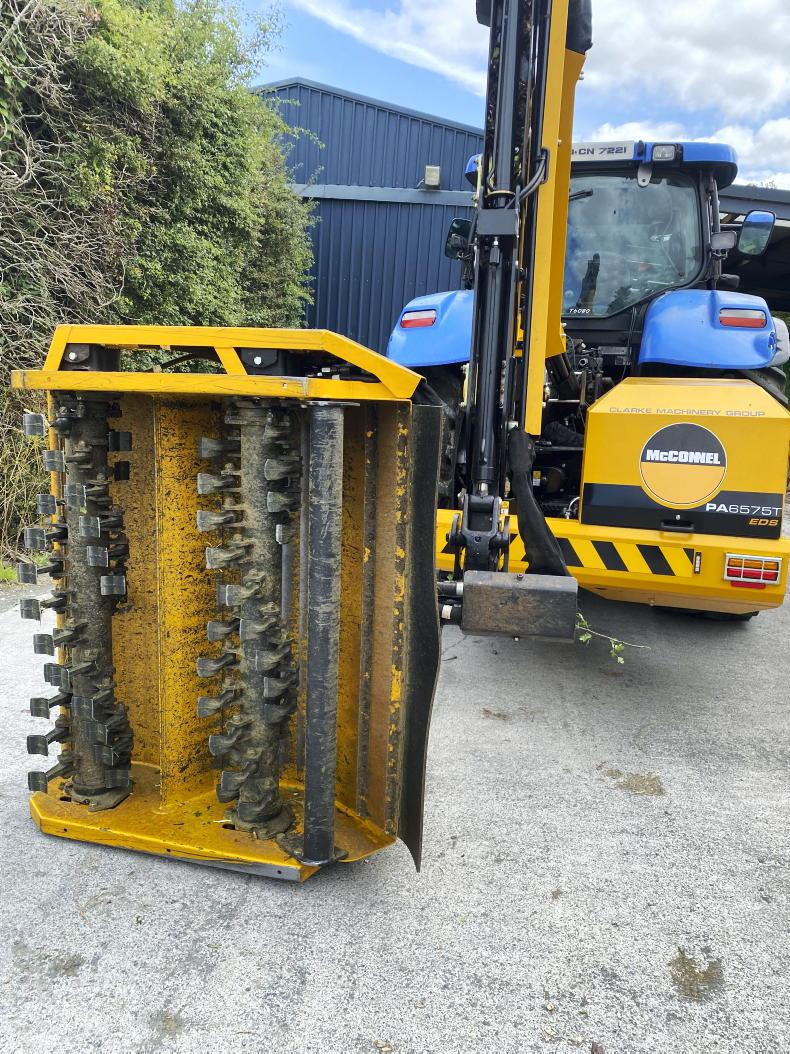
Featuring two high-powered spiral rotors, the Twincut flail head is available in two versions, 1.2m and 1.5m working widths.
Why a twin rotor head?
“We had been looking towards buying a Twincut head for the last couple of years. We found that in our area, farmers are not cutting hedges as frequently as they once were, for various reasons such as different environmental schemes and the very short windows for carrying out field work before ground conditions deteriorate.
“This has meant that regrowths are becoming stronger. We also work on a lot of heavy ground in our area, so with a demand to get through a lot of work in a short period of time and the foreseeable lack of labour and help down the line as being a major issue, we felt the move to a Twincut head made good sense”, explained Niall.
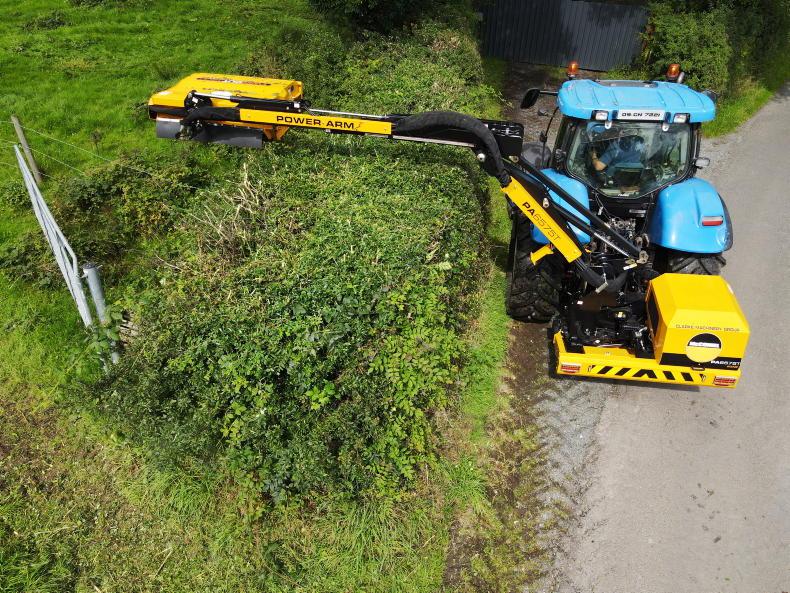
The first rotor is equipped with a heavy-duty T-flail which cuts in a downward direction, reducing the amount of debris blown forward.
The workings
McConnel designed its Twincut flail head to tackle hedgerows in a single-pass. It aimed to build a head that would deliver both a heavy-duty cut and a fine finish in a single operation. Featuring two high-powered spiral rotors, the Twincut flail head is available in two versions, 1.2m and 1.5m working widths.
The first rotor is equipped with a heavy-duty T-flail which cuts in a downward direction, reducing the amount of debris blown forward. It’s designed to finely mulch the material, while retaining the bulk in the hedgerow. The second rotor is then set 50mm lower. It cuts in an upward direction and is equipped with a fine-cut McConnel competition flail.
Amongst the advantages claimed by the manufacturer include increased daily productivity, fuel savings and reduced damage to fields with fewer passes.
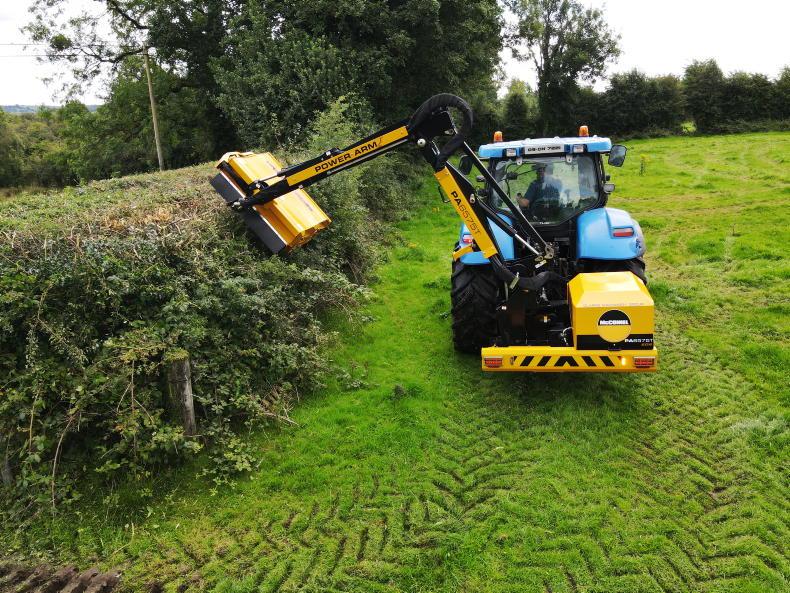
The second rotor is then set 50mm lower. It cuts in an upward direction and is equipped with a fine-cut McConnel competition flail.
Fitting the new head
“Clarke Machinery fitted the new head for us at their premises in New Inn. Between taking off the existing single rotor Tuffcut head and fitting the new Twincut head, they had it finished in the space of half an hour.
“It’s very easy to swap the heads. We decided to go for the 1.2m head. I would be afraid the 1.5m Twincut head would be too big for our setup”, added Niall.
The Sheridans run the McConnel 6575T with the Twincut head on a New Holland T6080. The new head with the additional rotor weighs in at 425kg, which is just over 100kg heavier than the standard 1.2m single rotor head which weighs in at 323kg.
Niall explained that they have the tractor ballasted with a 1,000kg front weight block on the front linkage, which balances the outfit quite well. He said that some wheel weights might be added before the cutting season opens up to compensate for the extra weight.
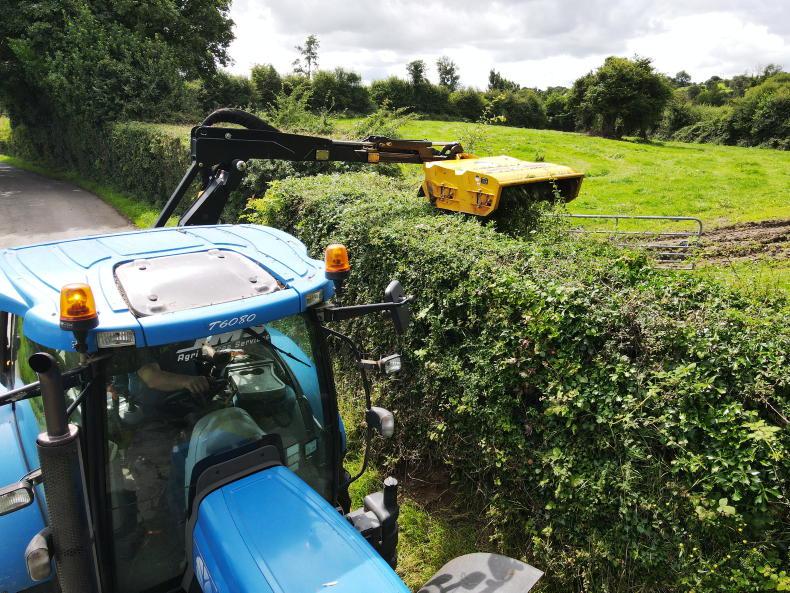
"We are very happy and I couldn’t see ourselves ever buying a single rotor head ahead again”.
Verdict to date
“There is no comparison between the Twincut and the single rotor head. I couldn’t believe the difference. It’s been a game changer for us. It allows us to get through work quicker and gives us the option of using it in four year growth, plus regrowth under ESB powerlines, where a single rotor machine simply wouldn’t work. When working in fields cutting two year’s growth you are getting away with one pass. This is especially beneficial if ground is soft, you are doing less damage to fields”.
“Running the twin rotor head is slightly harder on fuel, especially in heavier regrowth. On the flip side, the output is a lot higher, especially in such heavier growth. Our biggest concern when buying the Twincut head was would it be a logical investment, but it is – our output has increased and so has our rate accordingly.
“We find that you would gain a lot of output on one year regrowth, but it shows its true colours in two to three plus years’ regrowth, where you could get up to twice the output”.
“We find the new head to be easier cutting under fences and around trees in comparison to the single rotor head, down to the fact that the rotor is at the very front of the hood. However, in saying that you have to be extra careful around stays and poles with services running down them for fibre broadband etc.
“It does seem more awkward at first because of the sheer size of it, but it doesn’t take long to get used to. Another advantage I found is that because the head is bigger, you actually have a better view of it from the cab, so it’s easier on the operator’s neck.
“All in all, we are very happy and I couldn’t see ourselves ever buying a single rotor head again”, concluded Niall.
Specs
Model number: Twincut 12.
Cutting width: 1.2m.
Horse Power options: 65hp, 70hp or 85hp.
Rotor Type: 2 x Supercut.
Weight: 425kg (a standard 1.2m weighs in around 323kg).
List price: €13,500 plus VAT.
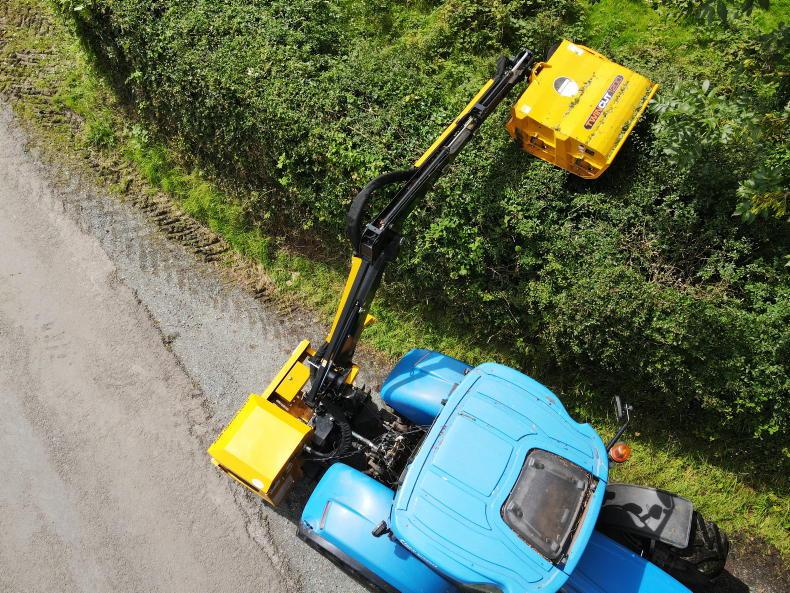
"Our biggest concern when buying the Twincut head was would it be a logical investment- but it is, our output has increased and so has our rate accordingly".
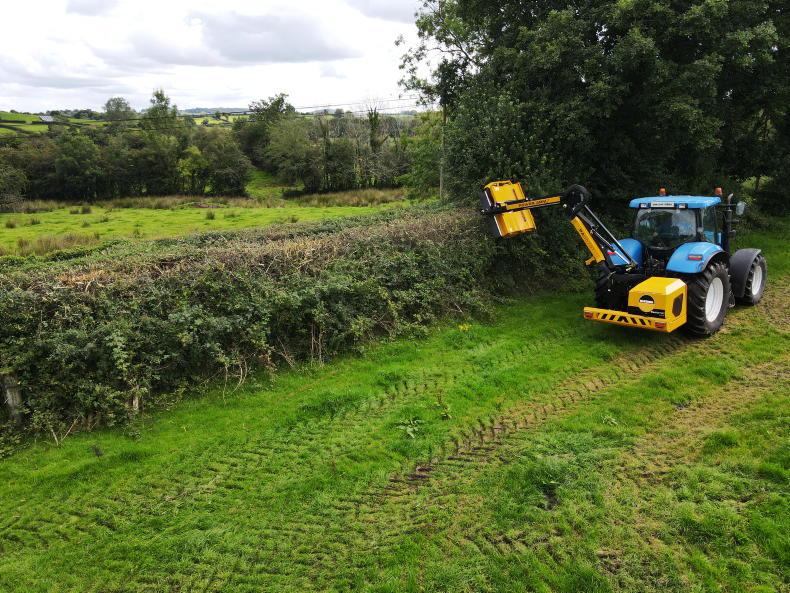
“There is no comparison between the Twincut and the single rotor head. I couldn’t believe the difference".
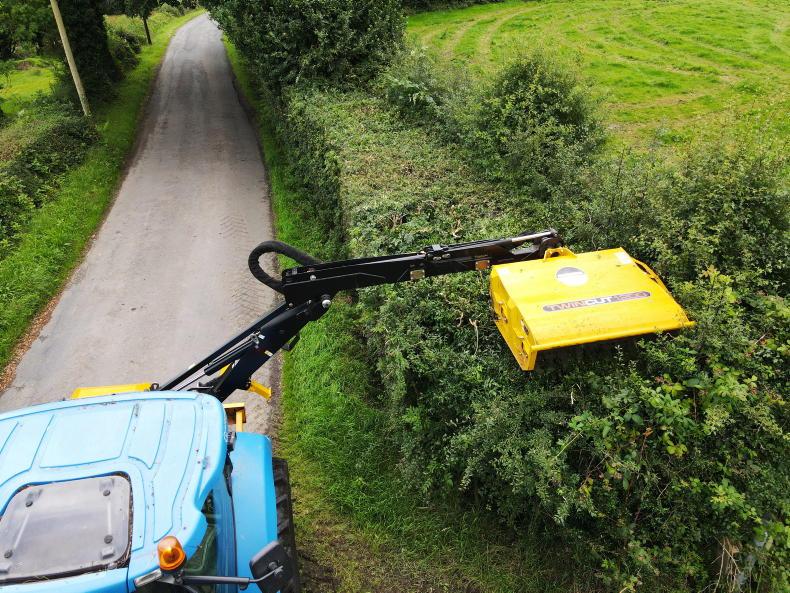
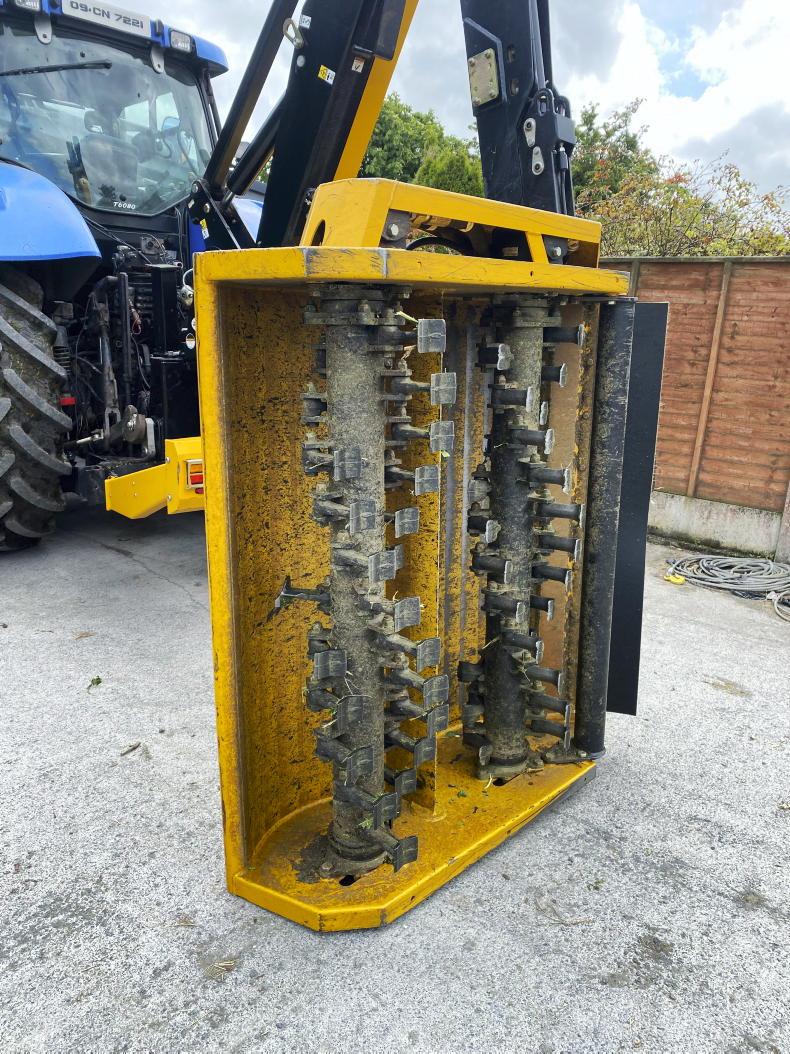
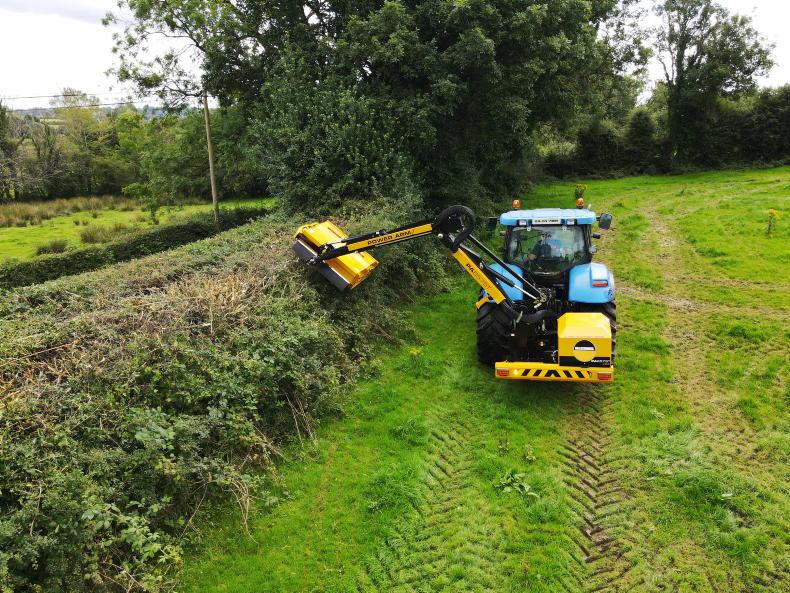
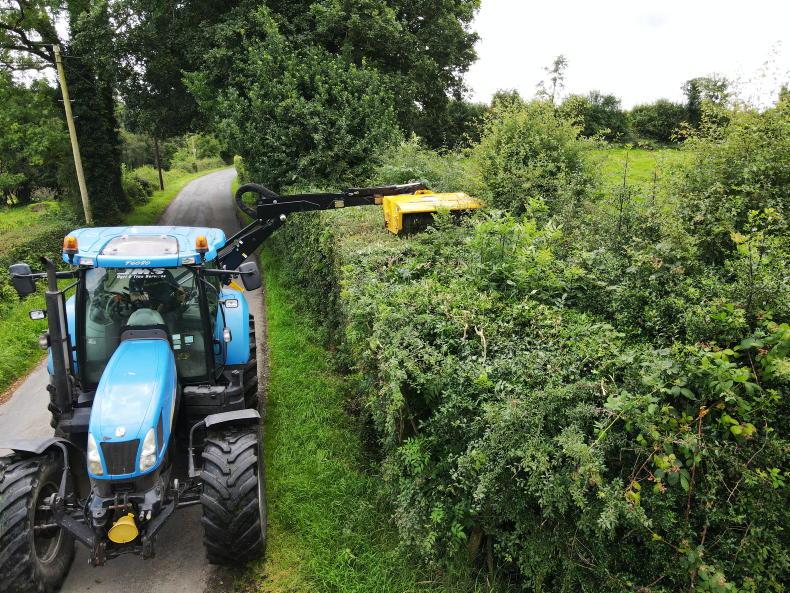
Based between the towns of Ballinagh and Arvagh in Co Cavan, JMS Agri and Tree Services is a family run business which is headed up by Jim Sheridan and his son Niall.
Carrying out a full range of tree services from tree removal to pruning to wood chipping, stump grinding and section felling, hedge cutting perfectly slots into the firm’s service portfolio alongside its agricultural contracting offering.
The Sheridans have been offering a hedge cutting service for almost 30 years now, and have been largely running McConnel since day one.
They currently run two flails hedge cutters, which include a one-year-old McConnel 6575T and a McConnel PA53E, alongside a Moffett tractor saw which was fitted on a new Ford New Holland 7840 back in 1998.
Always keen to get the most out of every machine in the fleet, the firm opted to fit a Twincut, twin rotor flail head to their one-year-old McConnel 6575T hedge cutter earlier this year.
We caught up with Niall Sheridan to find out how this has worked out to date.

Featuring two high-powered spiral rotors, the Twincut flail head is available in two versions, 1.2m and 1.5m working widths.
Why a twin rotor head?
“We had been looking towards buying a Twincut head for the last couple of years. We found that in our area, farmers are not cutting hedges as frequently as they once were, for various reasons such as different environmental schemes and the very short windows for carrying out field work before ground conditions deteriorate.
“This has meant that regrowths are becoming stronger. We also work on a lot of heavy ground in our area, so with a demand to get through a lot of work in a short period of time and the foreseeable lack of labour and help down the line as being a major issue, we felt the move to a Twincut head made good sense”, explained Niall.

The first rotor is equipped with a heavy-duty T-flail which cuts in a downward direction, reducing the amount of debris blown forward.
The workings
McConnel designed its Twincut flail head to tackle hedgerows in a single-pass. It aimed to build a head that would deliver both a heavy-duty cut and a fine finish in a single operation. Featuring two high-powered spiral rotors, the Twincut flail head is available in two versions, 1.2m and 1.5m working widths.
The first rotor is equipped with a heavy-duty T-flail which cuts in a downward direction, reducing the amount of debris blown forward. It’s designed to finely mulch the material, while retaining the bulk in the hedgerow. The second rotor is then set 50mm lower. It cuts in an upward direction and is equipped with a fine-cut McConnel competition flail.
Amongst the advantages claimed by the manufacturer include increased daily productivity, fuel savings and reduced damage to fields with fewer passes.

The second rotor is then set 50mm lower. It cuts in an upward direction and is equipped with a fine-cut McConnel competition flail.
Fitting the new head
“Clarke Machinery fitted the new head for us at their premises in New Inn. Between taking off the existing single rotor Tuffcut head and fitting the new Twincut head, they had it finished in the space of half an hour.
“It’s very easy to swap the heads. We decided to go for the 1.2m head. I would be afraid the 1.5m Twincut head would be too big for our setup”, added Niall.
The Sheridans run the McConnel 6575T with the Twincut head on a New Holland T6080. The new head with the additional rotor weighs in at 425kg, which is just over 100kg heavier than the standard 1.2m single rotor head which weighs in at 323kg.
Niall explained that they have the tractor ballasted with a 1,000kg front weight block on the front linkage, which balances the outfit quite well. He said that some wheel weights might be added before the cutting season opens up to compensate for the extra weight.

"We are very happy and I couldn’t see ourselves ever buying a single rotor head ahead again”.
Verdict to date
“There is no comparison between the Twincut and the single rotor head. I couldn’t believe the difference. It’s been a game changer for us. It allows us to get through work quicker and gives us the option of using it in four year growth, plus regrowth under ESB powerlines, where a single rotor machine simply wouldn’t work. When working in fields cutting two year’s growth you are getting away with one pass. This is especially beneficial if ground is soft, you are doing less damage to fields”.
“Running the twin rotor head is slightly harder on fuel, especially in heavier regrowth. On the flip side, the output is a lot higher, especially in such heavier growth. Our biggest concern when buying the Twincut head was would it be a logical investment, but it is – our output has increased and so has our rate accordingly.
“We find that you would gain a lot of output on one year regrowth, but it shows its true colours in two to three plus years’ regrowth, where you could get up to twice the output”.
“We find the new head to be easier cutting under fences and around trees in comparison to the single rotor head, down to the fact that the rotor is at the very front of the hood. However, in saying that you have to be extra careful around stays and poles with services running down them for fibre broadband etc.
“It does seem more awkward at first because of the sheer size of it, but it doesn’t take long to get used to. Another advantage I found is that because the head is bigger, you actually have a better view of it from the cab, so it’s easier on the operator’s neck.
“All in all, we are very happy and I couldn’t see ourselves ever buying a single rotor head again”, concluded Niall.
Specs
Model number: Twincut 12.
Cutting width: 1.2m.
Horse Power options: 65hp, 70hp or 85hp.
Rotor Type: 2 x Supercut.
Weight: 425kg (a standard 1.2m weighs in around 323kg).
List price: €13,500 plus VAT.

"Our biggest concern when buying the Twincut head was would it be a logical investment- but it is, our output has increased and so has our rate accordingly".

“There is no comparison between the Twincut and the single rotor head. I couldn’t believe the difference".




















 This is a subscriber-only article
This is a subscriber-only article










SHARING OPTIONS: